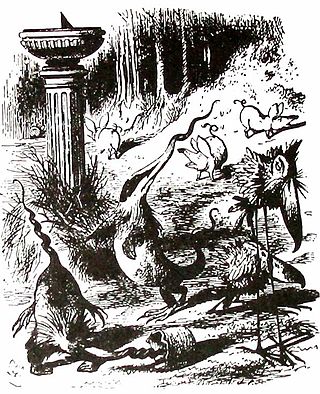
Edward Lear was an English artist, illustrator, musician, author and poet, who is known mostly for his literary nonsense in poetry and prose and especially his limericks, a form he popularised.

Sir John Tenniel was an English illustrator, graphic humourist and political cartoonist prominent in the second half of the 19th century. An alumnus of the Royal Academy of Arts in London, he was knighted for artistic achievements in 1893, the first such honour ever bestowed on an illustrator or cartoonist.

Nonsense verse is a form of nonsense literature usually employing strong prosodic elements like rhythm and rhyme. It is often whimsical and humorous in tone and employs some of the techniques of nonsense literature.

Thomas Bewick was an English wood-engraver and natural history author. Early in his career he took on all kinds of work such as engraving cutlery, making the wood blocks for advertisements, and illustrating children's books. He gradually turned to illustrating, writing and publishing his own books, gaining an adult audience for the fine illustrations in A History of Quadrupeds.
Sir Quentin Saxby Blake is an English cartoonist, caricaturist, illustrator and children's writer. He has illustrated over 300 books, including 18 written by Roald Dahl, which are among his most popular works. For his lasting contribution as a children's illustrator he won the biennial international Hans Christian Andersen Award in 2002, the highest recognition available to creators of children's books. From 1999 to 2001, he was the inaugural British Children's Laureate. He is a patron of the Association of Illustrators.

The Fox and the Grapes is one of Aesop's Fables, numbered 15 in the Perry Index. The narration is concise and subsequent retellings have often been equally so. The story concerns a fox that tries to eat grapes from a vine but cannot reach them. Rather than admit defeat, he states they are undesirable. The expression "sour grapes" originated from this fable.
Roger Gilbert Lancelyn Green was a British biographer and children's writer. He was an Oxford academic. He had a positive influence on his friend, C.S. Lewis, by encouraging him to publish The Lion, the Witch and the Wardrobe.

The Folio Society is an independent London-based publisher, founded by Charles Ede in 1947 and incorporated in 1971. Formerly privately owned, it became an employee ownership trust in 2021.

Literary nonsense is a broad categorization of literature that balances elements that make sense with some that do not, with the effect of subverting language conventions or logical reasoning. Even though the most well-known form of literary nonsense is nonsense verse, the genre is present in many forms of literature.
Michael Foreman is a British author and illustrator, one of the best-known and most prolific creators of children's books. He won the 1982 and 1989 Kate Greenaway Medals for British children's book illustration and he was a runner-up five times.
Gavin L. O'Keefe is an Australian-born book illustrator and designer. He resided in the USA for a number of years, returning to live in Australia in 2018. O'Keefe has been the dustjacket designer and illustrator for US publisher Ramble House for close to two decades. He is also one of the publisher's commissioning editors.

George Worsley Adamson was a book illustrator, writer, and cartoonist, who held American and British dual citizenship from 1931.

Charles Robinson (1870–1937) was a prolific British book illustrator.
Harold Jones was a British artist, illustrator and writer of children's books. Critic Brian Alderson called him "perhaps the most original children's book illustrator of the period". He established his reputation with lithographs illustrating This Year: Next Year (1937), a collection of verses by Walter de la Mare.
Gerald Hembdon Seymour Rose was a British illustrator of children's books. He won the 1960 Kate Greenaway Medal from the Library Association, recognising the year's best children's book illustration by a British subject, for Old Winkle and the Seagulls, written by his wife Elizabeth (Liz) Rose and published by Faber and Faber.
Brian Robb was a painter, illustrator, and cartoonist. He worked for Shell and London Transport, designing posters and advertisements, and as a cartoonist for Punch. During World War II, he served as a camouflage officer in the Western Desert. He taught at Chelsea College of Art before and after the war, before becoming head of illustration at the Royal College of Art.

There are more than 100 illustrators of English-language editions of Alice's Adventures in Wonderland (1865) and Through the Looking-Glass (1871), with many other artists for non-English language editions. The illustrator for the original editions was John Tenniel, whose illustrations for Alice and Looking Glass are among the best known illustrations ever published.
James Crain Michie was an English poet, translator and editor, of Scottish and American descent .
The Frog and the Fox is one of Aesop's Fables and is numbered 289 in the Perry Index. It takes the form of a humorous anecdote told against quack doctors.

Ernest Henri Griset was a French-born painter and illustrator noted for the humorous interpretations of his subjects. He specialized especially in animal illustrations many of which were made for children's books as well as magazines like Punch.















